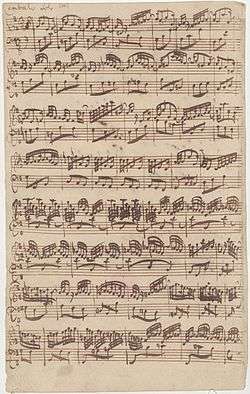Partita for keyboard No. 6 (Bach)

The Partita for keyboard No. 6 in E minor, BWV 830, is a suite of seven movements written for the harpsichord by Johann Sebastian Bach. It was published in 1731 both as a separate work and as part of Bach's Clavier-Übung I.
History
Prior to publication, two movements of BWV 830 formed part of the first version of the sixth sonata in E minor for obbligato harpsichord and violin, BWV 1019: the Corrente as a harpsichord solo; and the Tempo di gavotta as a duo for violin and harpsichord. The surviving manuscript, largely written by Bach's nephew Johann Heinrich Bach, has been dated to 1725; the harpsichord parts for these two movements were written by Bach himself. BWV 830 is the last suite in Bach's Clavier-Übung I, the first music published by Bach within his lifetime. The partitas were initially published separately, starting in 1726; the title page of the collection of six, published together in 1731, carries the designation "Opus 1". [1][2] [3]
Musical structure
This partita consists of seven movements all in E minor.
Reception and legacy
David Schulenberg describes this partita as "the crowning work of the set and Bach's greatest suite." Peter Williams, however, considers that some movements from Clavier-Übung I that were composed earlier than others, such as the Gigue from BWV 830, have a "grinding quality that is totally absent from the elegant and novel No. 1."[4][5]
American composer George Rochberg's harpsichord fantasia Nach Bach contains direct quotes from this partita.
Notes
- ↑ Schulenberg 2006
- ↑ Jones 2013, pp. 101–102
- ↑ Williams 2013, p. 318–322
- ↑ Schulenberg 2006, p. 340
- ↑ Williams 2013, p. 319
References
- Selected published editions
- Bach, J.S. (2004), Klaus Engler, ed., 6 Partiten, BWV 825–830, Wiener Urtext Edition, Schott/Universal Edition (contains detailed preface by Engler)
- Bach, J.S. (2008), Richard D. Jones, ed., Six Partitas, BWV 825-830, First Part of the Clavier Übung, Bärenreiter, ISMN 9790006465835 (contains detailed preface by Jones together with facsimiles of publications 1726–1731)
- Books and journal articles
- Jones, Richard D. P. (2013), The Creative Development of Johann Sebastian Bach, Volume II: 1717–1750: Music to Delight the Spirit, Oxford University Press, ISBN 9780199696284
- Schulenberg, David (2006), The Keyboard Music of J.S. Bach (second ed.), New York and London: Routledge, pp. 342–345, ISBN 0415974003
- Williams, Peter (2016), Bach: A Musical Biography, Cambridge University Press, ISBN 1107139252
External links
- 6 Partitas for keyboard, BWV 825–830: Scores at the International Music Score Library Project
- Partita No 6 E minor, BWV 830 on YouTube, Murray Perahia